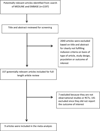Treatment effect, adherence, and safety of high fluid intake for the prevention of incident and recurrent kidney stones: a systematic review and meta-analysis
- PMID: 26022722
- PMCID: PMC4831051
- DOI: 10.1007/s40620-015-0210-4
Treatment effect, adherence, and safety of high fluid intake for the prevention of incident and recurrent kidney stones: a systematic review and meta-analysis
Abstract
Background: The objective of this systematic review and meta-analysis were to evaluate the effectiveness of high fluid intake for the prevention of incident and recurrent kidney stones, as well as its adherence and safety.
Methods: A literature search was performed encompassing 1980 through July 2014. Studies that reported relative risks, odds ratios, or hazard ratios comparing the risk of kidney stone events in patients with high vs inadequate fluid intake were included. Pooled risk ratios (RRs) and 95 % confidence intervals (CIs) were calculated using a random-effect, generic inverse variance method.
Results: Nine studies [2 randomized controlled trials (RCTs) with 269 patients; 7 observational studies with 273,685 individuals] were included in the meta-analysis. Pooled RRs of kidney stones in individuals with high-fluid intake were 0.40 (95 % CI 0.20-0.79) and 0.49 (0.34-0.71) in RCTs and observational studies, respectively. High fluid intake was significantly associated with reduced risk of recurrent kidney stones: RRs 0.40 (95 % CI 0.20-0.79) and 0.20 (0.09-0.44) in RCTs and observational studies, respectively. Adherence and safety data on high fluid intake treatment were limited; 1 RCT reported no withdrawals due to adverse events.
Conclusion: This analysis demonstrated a significantly reduced risk of incident kidney stones among individuals with high fluid consumption. High fluid consumption also reduced the risk of recurrent kidney stones. Furthermore, the magnitude of risk reduction was high. Although increased water intake appears to be safe, future studies on its safety in patients with high risk of volume overload or hyponatremia may be indicated.
Keywords: Fluid intake; Hyponatremia; Kidney stones; Meta-analysis; Water.
Conflict of interest statement
The authors declare no conflicts of interest in the conduct or write up of this project.
Figures



References
-
- Goldfarb DS. Increasing prevalence of kidney stones in the united states. Kidney Int. 2003;63:1951–1952. - PubMed
-
- Long LO, Park S. Update on nephrolithiasis management. Minerva Urol Nefrol. 2007;59:317–325. - PubMed
-
- Stamatelou KK, Francis ME, Jones CA, Nyberg LM, Curhan GC. Time trends in reported prevalence of kidney stones in the united states: 1976–1994. Kidney Int. 2003;63:1817–1823. - PubMed
-
- Qaseem A, Dallas P, Forciea MA, Starkey M, Denberg TD. Dietary and pharmacologic management to prevent recurrent nephrolithiasis in adults: A clinical practice guideline from the american college of physicians. Ann Intern Med. 2014;161:659–667. - PubMed
Publication types
MeSH terms
Grants and funding
LinkOut - more resources
Full Text Sources
Other Literature Sources
Medical

